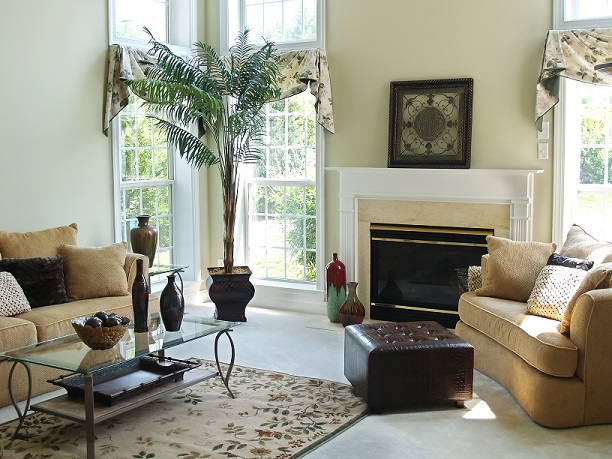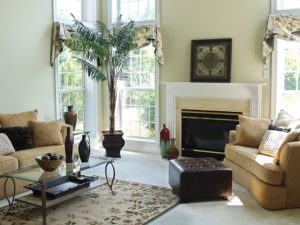Learn about the different types of carpet available to help you choose the right kind for your floor.
Experience the soft warmth of carpeting and enjoy a welcome landing spot for happy feet. Carpeting muffles sound to make any room more serene, and the plethora of textures, colors, and patterns enhances your style. You’ll also appreciate the built-in dirt-repelling technologies.
Many of today’s carpets can withstand pets, kids, and heavy traffic. Study the carpet types to help you determine which will stand up to the use of a particular room. Olefin, PET polyester, and triexta fibers all resist stains. Olefin and triexta fare well with household cleaners. Nylon and triexta are known for long wear in high-traffic areas, and both resist pilling and fuzzing.
Carpet Types
Berber Cut-Pile A fresh take on berber with a plush look, berber cut-pile feels thick underfoot and adds personality to any room through beautifully crafted and colored yarns. This carpet suits casual rooms and kids’ rooms, with subtle color flecks that hide soil between cleanings
Berber Loop-Pile and Multilevel Loop A wool-like carpet with a rugged loop surface, this carpet wears well and suits casual rooms with lots of traffic and activity as well as contemporary, country, or cottage furnishings. With its natural, handcrafted appearance, it also creates a warm, personal atmosphere and helps hide footprints and vacuum marks.
Cut-Loop A cut-and-loop pile carpet with discernible carved definition spices up floor surfaces with accent colors and suits both formal and contemporary settings. From soft tonal combinations to bolder color mixes, this carpet hides soil and stains with multicolor effects and looks great between vacuuming.
Saxony This refined cut-pile surface ideal for traditionally styled living and dining rooms adds distinctive elegance to any room. Lending a smooth, soft finish, this carpet shows subtle highlights and accents
Textured Plush A cut-pile carpet that works in a variety of settings and styles hides footprints and vacuum marks. Adding casual beauty to any room, textured plush is a great whole-house carpet and works well for busy households.
Fibers
Knowing the fibers available will help you make the best choice for your gathering rooms, bedrooms, and home offices:
Nylon
- Durable, resilient
- Abrasion resistant
- Wide selection of colors
- Favorably priced
- Must be treated to resist stains and soil
PET polyester
- Clarity in color; colorfast
- Resists water-soluble stains
- Luxurious feel
Triexta PTT
- Permanent stain protection
- Resists wear
- Easy maintenance
- Dries quickly
- Luxurious feel
Olefin polypropylene
- Resists fading, chemicals, moisture, and stains
- Limited color selection
- Generates static electricity
- Favorably priced
Carpet Color
There are essentially two ways in which color is created in today’s carpets: Postdyed, or stock-dyed, carpets are dyed after tufting. Most residential carpets are postdyed. Although the color is on the surface of the fiber, new dye additives provide better color retention than ever before, which means the color stands up to sunlight and regular cleaning with less fading. Solution-dyed, or predyed, carpets feature yarns dyed before being sewn together or tufted. This dying method is extremely colorfast and results in color throughout the thickness of the fiber, so fading is less of an issue. Predyed carpets tend to be more expensive than postdyed products.
Combine Carpet & Other Flooring Material
If you have a beautiful wood or stone floor but love the warmth and softness of carpet, it’s possible to have the best of both flooring types. Add an area rug, or have the edges of a piece of carpet finished to look like a custom area rug to fit a room of any size or shape. The edges can be finished with binding or serging. A binding finish is created by stitching a narrow strip of fabric over the edge of the carpet to give it a finished look and prevent raveling. Serging is a whipstitched finishing technique that encases the carpet edge in thread. It is used frequently on Oriental rugs and loop-pile (berber) carpet. Heavy carpets may need to be serged by hand because they are too thick to feed through a carpet-binder machine. Decorative fringe can be sewn onto the edge of a carpet to make it look like a larger area rug.
Replacing Your Carpet
When it’s time to replace your carpet, consider environmental impact. For example, carpet composed of Anso nylon fibers is completely recyclable into new carpet. Carpet made from postconsumer materials (such as plastic soda bottles) or from readily renewable agricultural resources (such as corn) has less of an impact on the environment than carpet that can’t be recycled. Just like any carpet, these environmentally friendly products feel soft underfoot and make an excellent flooring choice for gathering rooms, bedrooms, and home offices.
Most residential carpets made in the United States feature tufts of yarn stitched through a backing fabric. A latex coating sets these tufts in place and anchors them to a secondary backing. Tufts pulled through the backing can either be looped or cut, producing various textures. Here are the most popular styles:
Saxony: Level-cut pile is made up of closely packed tufts; luxurious surface good for formal settings.
Plush: Also called velvet; yarn is longer than a saxony, but is less dense; good for informal rooms.
Frieze: Twisted tufts that curl at the surface create a textured look that hides footprints; suitable for high-traffic areas.
Level Loop: Uncut pile contains loops of yarn of the same height; hides dirt well in high-traffic areas.
Multilevel Loop: Two or three levels of tufts form a random, sculptural look for informal and formal rooms.
Cut-and-Loop (or Cut-Loop): Higher tufts of cut yarn combine with lower loops for informal settings.
Fiber: Although the overall choice here is either synthetic or natural, several fibers are available in the synthetic category.
Wool: Noted for its soft, luxurious feel, but may be less resilient than synthetics, and carpets usually costs more.
Sisal: Made from plant fiber, and popular for its textured look.
Nylon: The strongest, most resilient carpet fiber; good for all traffic areas.
Polyester: Soft to the touch, but less resilient than nylon; resists water-soluble stains; carpets better suited for low-traffic areas.
Olefin: Resists moisture and mildew; suitable for both indoor and outdoor applications.
Acrylic: Often used in plush or level-loop carpet; offers the luxurious appearance and feel of wool at a lower price.
In addition to noting the fiber, pay attention to how the carpet is manufactured. Check the following:
Yarn Twist: All yarns in cut-pile carpeting have been twisted and heat-set to retain the twist. The tighter the twist, the longer the carpet will keep its original appearance. Typically, carpets feature yarns with 2.5-6.0 turns per inch, with most in the 3.5-5.0 TPI range.
Pile Height: Shorter nap resists crushing and looks newer longer.
Density: The amount of yarn used and the closeness of the tufts has a large impact on performance. Denser carpets will be more crush-resistant. To determine density, bend the carpet. Less backing will show in denser carpets.
Matney Construction, located in Mount Airy, Maryland, specializes in building new homes and residential remodeling. We know that the decision to build or remodel a home is no easy thing. As a family owned and operated business, we work closely with our clients to create their dream home, from custom floor plans and options, to bath and kitchen remodels. Whether it’s a single room or an entire home, we pride ourselves on meeting your quality standards, timeline and budget. Contact us today to have our professional design experts help you make your home unique, stylish, and in-tune with your personality. (410) 635-2500 info@matneyservices.com
Source: https://www.bhg.com/home-improvement/flooring/types/choosing-carpet/


